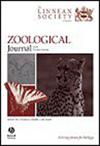Artemia monica(甲壳纲:无尾目)的分类地位
IF 3
2区 生物学
Q1 ZOOLOGY
引用次数: 0
摘要
物种是自然界的基本单位,需要正确识别,以评估和保护生物多样性。Artemia是一种示范性甲壳动物,可用于分析和比较分布在世界各地干旱和半干旱地区的高盐湖、泻湖和晒盐场中的区域特有有性物种和孤雌生殖品系。两个美洲蒿属物种的分类一直存在争议:Artemia monicaVerrill,1869 年,适应于莫诺湖(美国加利福尼亚州)富含碳酸盐的环境;Artemia franciscanaKellogg,1906 年,广泛分布于美洲。尽管前者已被世界自然保护联盟红色名录列为濒危物种,但对其研究甚少。相比之下,后者已被广泛研究,广泛分布于美洲,并已在欧洲、亚洲、非洲和澳大利亚成为非本地入侵物种。鉴于保护 A. monica 的需要、入侵 A. franciscana 的种内多样性以及该物种入侵地区的当地物种,我们重新考虑了它们的生物多样性和分类地位,目前它们正受到同义化的威胁。总之,A. monica 和 A. franciscana 应被视为两个独立的物种,它们在生态和繁殖上都是孤立的。本文章由计算机程序翻译,如有差异,请以英文原文为准。
The taxonomic status of Artemia monica (Crustacea: Anostraca)
Species are fundamental units of nature that need proper identification in order to assess and conserve biodiversity. Artemia is a model crustacean for population analysis and comparison in regionally endemic sexual species and parthenogenetic lineages distributed in hypersaline lakes, lagoons, and solar saltworks scattered in arid and semi-arid areas worldwide. The taxonomy of two American Artemia species has been controversial: Artemia monicaVerrill, 1869, adapted to the carbonate-rich conditions of Mono Lake (CA, USA), and Artemia franciscanaKellogg, 1906, a species broadly distributed in the Americas. The former species has been studied little, despite being listed as threatened in the IUCN Red List. In contrast, the latter has been studied extensively, is broadly distributed in the Americas, and has become established as a non-native invasive species in Europe, Asia, Africa, and Australia. Given the need to conserve A. monica, the intraspecific diversity of invasive A. franciscana, and the local species in areas invaded by this species, we reconsider their biodiversity and taxonomic status currently threatened by synonymization. In conclusion, A. monica and A. franciscana should be treated as two separate species that are isolated both ecologically and reproductively.
求助全文
通过发布文献求助,成功后即可免费获取论文全文。
去求助
来源期刊
CiteScore
6.50
自引率
10.70%
发文量
116
审稿时长
6-12 weeks
期刊介绍:
The Zoological Journal of the Linnean Society publishes papers on systematic and evolutionary zoology and comparative, functional and other studies where relevant to these areas. Studies of extinct as well as living animals are included. Reviews are also published; these may be invited by the Editorial Board, but uninvited reviews may also be considered. The Zoological Journal also has a wide circulation amongst zoologists and although narrowly specialized papers are not excluded, potential authors should bear that readership in mind.

 求助内容:
求助内容: 应助结果提醒方式:
应助结果提醒方式:


